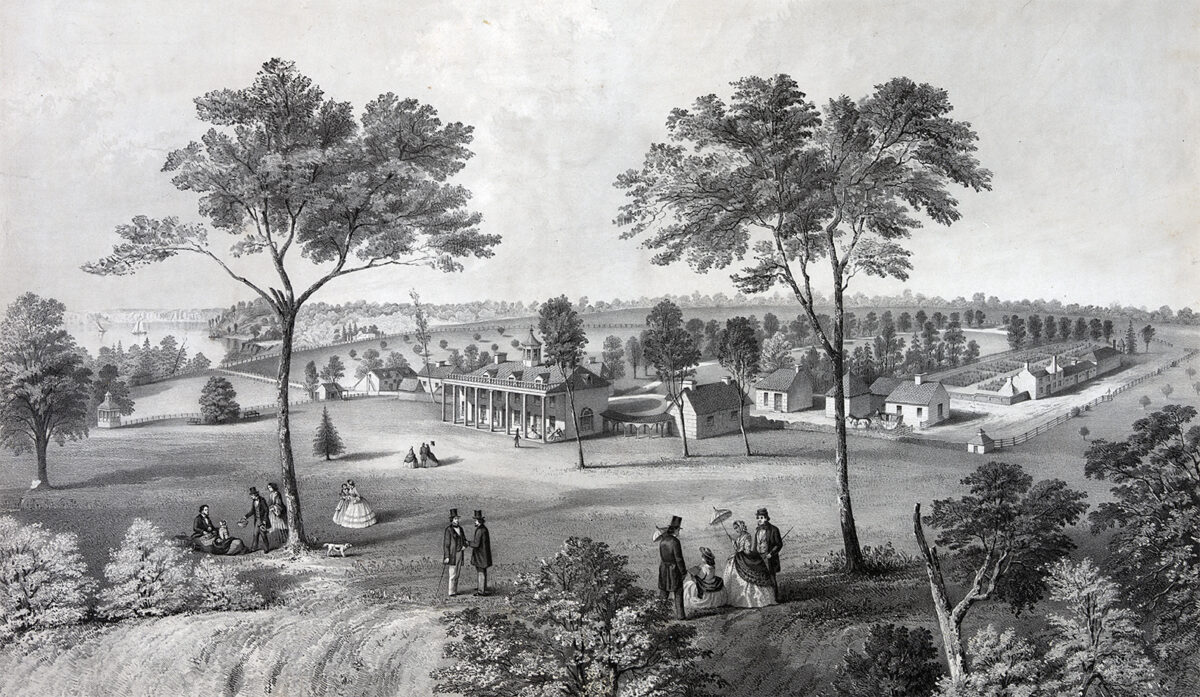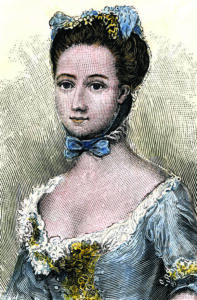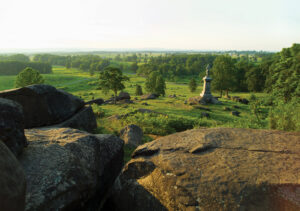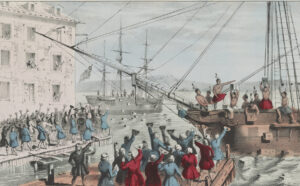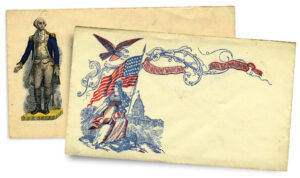“I consent to your commencing a distillery, and approve of your purchasing the Still, and entering of it. And I shall not object to your converting part of the Coopers shop at the Mill to this operation.” With these words, penned in 1797 to his recently hired farm manager, James Anderson, George Washington took another major step toward improving the financial success and independence of his vast estate.
The Virginia planter had already served his native land as a surveyor, British officer during the French and Indian War, member of the Virginia House of Burgesses, Continental Congress delegate, commander of the Continental Army during the Revolutionary War and two-term president of the United States. Throughout the trials and tribulations of his public life —its honors and accolades— it appears, however, that Washington’s true passion remained his Mount Vernon home. Even during the long absences imposed by his public duties, he remained in almost constant contact with family and staff about its most mundane operations. From the time of its acquisition until his death, Washington strove to make Mount Vernon the most modern, most diversified, most efficient and most profitable plantation possible. As a result, he acquired new lands, experimented with new crops, tried new techniques in farming and animal husbandry, ran commercially successful fisheries, a gristmill and even a distillery.
Originally known as Little Hunting Creek Plantation, Washington’s holdings were part of a land grant that was given to one of his ancestors by the British crown in 1674. The property eventually passed down to George’s elder half-brother, Lawrence. He renamed the property Mount Vernon to honor British Admiral Edward Vernon, with whom he had served during Britain’s 1739-1741 conflict with Spain known as the War of Jenkins’ Ear. (For having introduced a ration of rum to the British sailor’s routine, Admiral Vernon was affectionately known as “Old Grog.”) Soon after Lawrence’s death in 1752, 20-year-old George became sole owner of the roughly 2,300-acre plantation.
Almost immediately Washington began expanding his holdings through the selective purchase of nearby properties, and by 1787 had increased his estate to nearly 8,000 acres, organized into five farms. Each provided something unique to his operation—a beautiful spot for home and gardens overlooking the Potomac, deep-water access for ease of shipping raw materials and manufactured goods, lucrative fishing grounds, proper conditions for a commercial gristmill, decent farmland.
Initially, Washington tied his fortune to the cultivation of tobacco, but by the early 1760s he began to despair of ever making a real profit from that labor-intensive monoculture. In dealings with British markets, the shipping fees, import and export duties, brokerage charges and other commissions often ate up as much as 80 percent of the total sale. When these high costs were exacerbated by Great Britain’s unilateral imposition on the Colonies of the Sugar and Stamp acts, Washington, for economic and, increasingly, political reasons, sought new sources of revenue. He began by dedicating some of his land to wheat as a cash crop instead of tobacco. Between 1765 and 1770 his annual grain production grew from 257 bushels to 6,241, and this success proved to him that foregoing tobacco and diversifying his crops offered new growth opportunities.
Washington kept abreast of the latest theories and techniques of farming, trying new practices such as crop rotation; expanded compost and fertilizer preparation, storage and application; and erosion control through cross plowing. And he maintained detailed records of his successes and failures. Mount Vernon eventually produced more that 60 different crops, including wheat, corn, buckwheat, barley, oats, clover, pasture grasses, flax, cotton, potatoes and peas. Ever the experimenter, Washington also purchased and tested the latest farm tools and equipment, even making his own modifications to the plow. “I am never sparing,” he wrote in 1793, “in furnishing my Farms with any, and every kind of tool and implement that is calculated to do good and neat work…I shall begrudge no reasonable experience that will contribute to the improvement and neatness of my Farms….”
Livestock too played an important role in Washington’s plans as a source of power, food, hides, wool and manure. By 1758, Washington managed 100 sheep, years before it was common practice with other Virginia planters. He valued them for meat, wool for spinning and hides for tanning. He used selective breeding to improve his flock, which eventually numbered around 600. Thomas Jefferson considered Washington one of the finest horsemen of his time. Although he enjoyed horse racing, owning an Arabian for that purpose, Washington viewed horses primarily as work animals. As early as 1760, he had begun a breeding program for both work and riding horses and was constantly on the lookout for excellent specimens to improve his herd. Initially he followed the common practice of allowing his hogs to roam freely during the summer, rounding them up in the fall and selecting animals to be fattened and slaughtered. Realizing that system was rather chaotic and very inefficient, he eventually constructed roofed pens with planked floors, a supply of fresh water and feeding troughs to increase fattening as well as to better protect and control his assets.
In the comparative lull between the Revolutionary War and his first term as president, another of his experiments began to change the face of American agriculture. Beginning with a jackass, received as a gift in 1785 from Spain’s King Carlos III, plus another one and two female donkeys, given to him by the Marquis de Lafayette, the ex-general began breeding them and cross-breeding donkeys with horses to produce mules. Tests convinced him that mules were stronger, had more endurance and required less food than workhorses. His successes and proselytizing, to say nothing of the sale of his excess stock of mules and donkeys, greatly increased the popularity and availability of mules as farm animals throughout the United States.
While Washington constantly strived to improve his agricultural and livestock production, he also increasingly looked for ways to reduce his expenditures and increase his income. At the time he took control of the estate, there was a small blacksmith shop that not only filled the needs of Mount Vernon itself but also provided goods and services to neighbors within a five-mile radius of the property. Although initially a viable business that added needed income, as new lands were acquired it was required more and more to service the plantation. While its outside business function virtually ceased, it did serve as a model for other enterprises. Using primarily the cotton, flax and wool produced at Mount Vernon, in the mid-1760s Washington initiated a successful small cloth manufacturing operation that spun and wove cotton, linen and wool for both plantation use and sale. These small experiments helped Washington realize that increasing production of such goods and services onsite reduced the amount of cash he had to pay to buy from others, and conversely that anything produced beyond his own needs could be sold. He began to look for larger opportunities.
From time immemorial, first Native Americans and then European settlers had been harvesting the fish of the Potomac River, especially when the herring and shad ran upriver to spawn near Great Falls some 30 miles above Mount Vernon. Washington was no exception. During this annual spring run, slaves, indentured servants and even overseers were pulled from preparing the fields to seine as many fish for salting and future use as possible. As sugar production exploded in the West Indies, the need for cheap yet sustaining food to feed the ever-increasing number of slaves who worked the cane fields exploded as well, and Washington saw another opportunity. Using good river sites gained through his earlier strategic land purchases, he set up three fisheries and began shipping salted fish to the islands. Sometimes Washington leased them out to tenants to run, freeing his laborers to work the fields during fishing season. In 1770, one of those tenants, using nets 210 feet long and 20 feet high, pulled 480,000 herring and shad from the Potomac. These fisheries were his first big success at large-scale commercialization.
As grain production increased through the years, it overwhelmed the plantation’s threshing and milling facilities. To help handle the increasing volumes and operate more cleanly and efficiently, Washington ordered construction of a large 16-sided, two-story round barn of his own design. Completed in 1795, it was the first of its kind in America. It was built into an embankment, so that horses entered the barn at the top level. As they circled the building they trod on the grain on heavy floorboards that were evenly spaced to allow the separated kernels to fall below while the straw and chaff remained above. At the same time, Washington took steps to improve his milling capacity. After purchasing a pair of high-quality millstones from Europe, he replaced the gristmill that his father had built in the 1730s with a new one located closer to the Potomac, which offered easier transshipment of flour and cornmeal on the river. This new mill not only allowed him to process his own harvests but also permitted him to mill grain, for a fee, for other local farmers. He further enhanced the operation in 1791 by replacing his mill machinery with a more automated system—a new design by Delaware inventor Oliver Evans, in which all parts of its operation were powered by the mill wheel. The improved system was far more efficient, requiring only two men; the older operation had needed five.
Up until January 1797, fewer than three months before he officially retired from the presidency, almost all of Washington’s efforts to increase self-sufficiency and revenues were natural extensions of what he and his forebears had been doing all along. That changed when James Anderson, a Scotsman with knowledge of the distillation of spirits, took over the day-to-day management of Washington’s huge Virginia estate. Before the month was out, Anderson made a revolutionary, not evolutionary, proposal to his boss. He suggested establishing an entirely new enterprise: a distillery.
Washington needed some convincing. He knew little of the business and even had fears that a distillery might attract some rather unsavory folk. If they were to build it, he suggested, the operation should be located close to the mansion, so a watchful eye could be kept on the customers. Anderson, on the other hand, having quickly sized up Mount Vernon’s holdings, operations, outbuildings and water sources, proposed placing the distillery near the gristmill. With an eye toward efficiency and a minimal initial cash outlay, he may have argued that by so doing, all grain could be sent to this central location for both types of processing, and the mill and the distillery could share a water source and common river landing for shipping their products by boat to market. In addition, there was a little-used cooperage building on the site that could be converted. When Washington wrote to Anderson consenting to “commencing a distillery,” his decision to trust his newly hired manager turned out to be a wise one.
In the early days of the Colonies, rum, derived from fermented sugar cane, had been the most commonly consumed hard liquor. Both during and after U.S. independence, however, Great Britain dominated much of rum production and its distribution in North America. Making a political statement, more and more Americans shunned British-controlled rum and sought a cheaper alternative: The demand for grain-based whiskey blossomed. The distillation of spirits from grain was not new to the United States. Farmers, especially those in the far western reaches of the new nation, had long recognized that it was easier and more profitable with less spoilage to ship whiskey over bad roads or waterways than the bulkier grain from which it was derived. In addition, beginning in the early 1700s conditions in the British Isles caused a decades-long emigration to the New World. Among the immigrants were large numbers of Scotch-Irish folk, with a long tradition of distilling and drinking such spirits. They brought with them their traditions and desire for grain-based alcohol, and their skills and expertise helped meet the rising U.S. demands. James Anderson was of such stock.
Anderson quickly began distilling at the cooperage. Crushed grain and malt were poured into tubs of hot water, where the grain’s starch was converted to sugar. Yeast was added to the cooled mash to start the process of fermentation. After a few days, the fermented mash was then placed into the bowls of two stills, and the bowls were heated. Since alcohol boils at a lower temperature than water, it evaporates first, rising into a tube, or worm, where it cools, condenses and runs into a receptacle. By February 22, barely a month after receiving permission to set up shop, Anderson had barreled and stored 80 gallons of whiskey.
Four months later, in June, Anderson proposed a major expansion of the distillery. To make it a truly commercial enterprise, he wanted to purchase, for an estimated cost of $640, three new stills, several mash tubs and a new boiler. In addition, he proposed the building of a new structure to house the stills and a smaller malting house, professing ignorance of how to estimate the cost of their construction.
Before making the decision about a large expansion of this still-unfamiliar business, Washington asked the advice of his rum distiller friend, John Fitzgerald, in nearby Alexandria, Va. Fitzgerald wrote back almost immediately: “As I have no doubt but Mr. Anderson understands the Distillation of Spirit from Grain I cannot hesitate in my Opinion that it might be carried on to great advantage on your Estate.” He continued by asserting that, if the quality was good, the proposed operation could sell 10 times as much as it could produce. Reassured, Washington wrote to Anderson that the distillation of spirits “is a business I am entirely unacquainted with, but from your knowledge of it and from the confidence you have in the profit to be derived from the establishment, I am disposed to enter upon one….”
During the last half of 1797, a new stone building was erected and the new equipment, including three copper stills manufactured in Alexandria, was purchased and installed. The distillery was in full swing by January of the following year. The tools and nature of the operation are fairly well understood from surviving documents. On the site, there were as many as 50 mash tubs, and a kiln for malting and slop coolers to prepare the used mash as food for swine. The centerpiece, though, was the massive, one-story, 30-foot-by-75-foot stone structure that housed the heart of the distillery. Built of sandstone blocks quarried from Mount Vernon properties upon a foundation of river stone transported from Great Falls, it enclosed 2,250 square feet.
The five stills held a total of 616 gallons of mash. Each had its own worm and a receptacle. Specially designed wooden troughs transported water into the building to help cool the vapors in the worms. Brick furnaces and a stove provided heat for the stills and boiler. There was also a large storage cellar in which to lock up the barreled whiskey, perhaps to protect it from the undesirable elements Washington had first feared might be attracted to the operation.
What the documents do not provide, however, is a full understanding of how the equipment was arranged within the building. There remain no descriptions or drawings showing the relative placement of heat sources, stills, water troughs and other necessary components.
James Anderson’s son, John, was put in charge of the expanded distillery, and six slaves—Hanson, Peter, Nat, Daniel, James and Timothy—were assigned to the operation. The endeavor was an immediate success. By the end of 1798, the new five-still setup quickly set a pace that would yield roughly eight times the production of the two-still operation during 1797. The immense increase in production, however, quickly resulted in unforeseen problems for its owner. With all five stills running full time, the operation was quickly going through the corn available on the plantation. Some years before, Washington had begun limiting the amount of corn grown at Mount Vernon, preferring to cultivate more lucrative grains such as wheat. That earlier decision now came back to haunt him. Having assumed that he could operate with the corn grown on his own lands, he now found himself purchasing extra corn for the distillery, a cash outlay he had not anticipated.
Washington explained his predicament to his nephew William Augustine Washington: “My lands are not congenial with this Crop, and are much injured by the growth of it….Nothing but the indispensable use of the food for my negros (and indeed for Hogs) has restrained me from discontinuing it altogether….” He also expressed his desire to establish an ongoing agreement with his nephew for the purchase of 500 barrels of corn annually. Most of that corn was destined for the mash tubs. Concerned about how to pay for the needed corn, he wrote Robert Lewis, one of his business representatives: “I have been induced…to erect a large Distillery at my Mill…which…has cost me a considerable sum already, but I find these expenditures are but a small part of the advances I must make before I shall receive any return for them….I beg you to exert yourself in the collection of my Rents, and that you would let me know…not only as to the amount of the sum, but also as to the period of its payment, that I may regulate matters accordingly.” In addition, Washington had to search for new markets for his alcohol. In another letter to William, he mentioned having sent him two barrels of whiskey, adding: “if you should want more, or any of your neighbors any, it would be convenient, & always proper to supply you—and for grain, Rye or Indian Corn in exchange.”
Washington maintained meticulous records of most of his plantation’s activities, and the distillery was not excepted from the practice. Detailed ledgers list production figures, grain purchases from whom and for how much, and at what price what quantity of what type of liquor was sold to whom. The ledgers show that during the life of the distillery, “whiskey”—unaged corn liquor of a kind that might later have been called “moonshine,” “white dog” or “white lightning”—made up roughly 90 percent of his whiskey production and sales.
Washington hoped to diversify this operation, and he experimented with varying qualities of whiskeys. One ledger records that, by further processing his basic product or adding flavors such as cinnamon and persimmon, he produced small quantities of at least six other whiskeys—”common,” “rectified,” “fine rectified,” “rectified 4th proof,” “strong proof” and “rye whiskey.” These specialized, higher grades made up the remaining 10 percent of his whiskey production. He also distilled small quantities of apple and peach brandies and rum.
Guided by James Anderson, the expanded distillery produced the mainstay whiskey in large quantities year round. While some was reserved for use on the plantation, most was shipped to as many as 270 clients. It was a diverse group containing a number of merchants, innkeepers, grocers and other businessmen and women who presumably resold it to their own clients. Individuals—overseers, boatmen, neighbors, planters, a cartwright, a weaver, a butcher, among others—apparently obtained the whiskey for their own personal consumption or that of their employees and slaves. While cash payments were made in many cases, the whiskey was also bartered for quantities of corn, wheat, rye, salt, mustard, clover seed and a wide miscellany of other items. (Presumably much of that grain was used in the production of more whiskey.) Some of Washington’s overseers and contract laborers, as well as a doctor and a seamstress, accepted quantities of whiskey in partial fulfillment of negotiated contracts for services to the plantation. While most of the clientele were from Alexandria and the Maryland and Virginia counties neighboring Mount Vernon, at least one batch was shipped as far away as Richmond, Virginia, indicating a possible expansion of the market.
Of the specialty grades, made only in the spring and fall, limited quantities were kept for Washington’s personal use. The rest went to only seven people—all either prominent businessmen, family members or close friends, and to his physician—in exchange for cash, goods and services.
Upon Washington’s death on December 14, 1799, the distillery, which became the property of his nephew Lawrence Washington, began to fall into decline. The Andersons—father and son—continued to oversee its operation during the next four years until they were discharged by the new owner. Lawrence then rented the distillery out for another five years. Record keeping degenerated during this time period, but an advertisement in an Alexandria, Virginia, newspaper offering Mount Vernon whiskey for sale that appeared as late 1808 suggests that the distillery was still producing then. Soon thereafter, however, the operation was closed down and the distillery was dismantled to provide building materials for nearby homes. It was a sad end for a business Washington had nurtured into one of his primary revenue and profit makers. The expanded distillery possessed the largest distilling structure with one of the largest capacities in the Chesapeake region and perhaps the nation. Its total output jumped from about 660 gallons of alcohol in 1797 to roughly 4,270 in 1798 and, in its record year, 1799, to nearly 10,000 gallons, with an estimated profit for that year of a hefty $7,500. Although comparative numbers are hard to find, since detailed records such as those kept at Mount Vernon were a rarity at other distilleries across the country, it is clear that Washington’s distillery was among the top producers of its time.
George Washington influenced virtually every aspect of the process that united 13 colonies into nationhood. His leadership can be seen in our military, political, judicial, legislative, agricultural and economic systems. He was eulogized by friend and fellow soldier Henry Lee as “first in war, first in peace, and first in the hearts of his countrymen.” Had he been able to apply his personal touch to the distillery just a few years longer, he might have become first in that endeavor as well.
This article was written by Philip Brandt George and originally published in February 2004 issue of American History magazine. For more great articles be sure to pick up your copy of American History.

